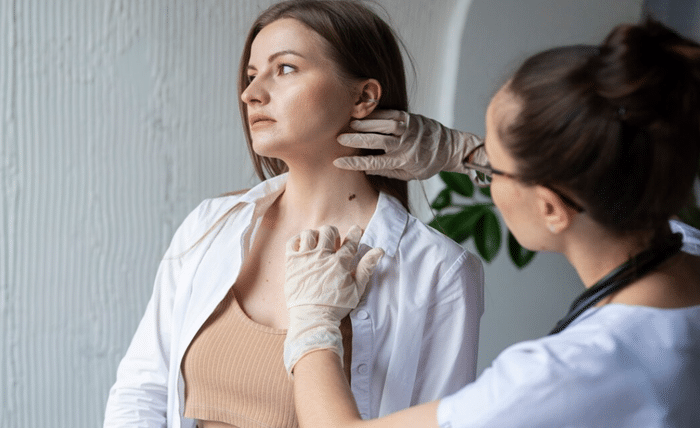
Warts and molluscum contagiosum are common skin conditions in children, often causing discomfort and concern for parents. These viral infections can spread quickly through skin-to-skin contact, shared items, or even minor cuts and scrapes. A pediatric dermatologist specializes in diagnosing and treating these conditions, helping children recover quickly while preventing further spread. Early intervention can make a significant difference in managing symptoms and avoiding complications. You can find more information on the available treatment options if you seek expert care for your child’s skin concerns.
1. Understanding Warts and Molluscum Contagiosum
What Are Warts?
Warts are small, rough skin growths caused by the human papillomavirus (HPV). They can appear anywhere on the body but are most commonly found on the hands, fingers, knees, and feet.
Types of Warts Found in Children:
- Common warts: Rough, raised bumps typically on the hands and fingers.
- Plantar warts: Hard, flat warts that grow on the soles of the feet, often causing discomfort while walking.
- Flat warts: Smooth, small warts that usually appear in clusters on the face or legs.
- Filiform warts: Thin, thread-like warts that develop around the mouth, nose, or eyes.
What Is Molluscum Contagiosum?
Molluscum contagiosum is a viral skin infection caused by the molluscum contagiosum virus (MCV). It results in small, round, flesh-colored bumps with a central dimple. While generally harmless, these lesions can be itchy, inflamed, or become infected due to scratching.
2. How Pediatric Dermatologists Diagnose Warts and Molluscum
Physical Examination
Pediatric dermatologists typically diagnose warts and molluscum through a simple visual inspection. The distinct appearance of these lesions makes them easy to identify without the need for invasive testing.
Dermoscopy
Sometimes, a dermatologist may use a dermatoscope, a specialized magnifying tool, to examine skin lesions more closely. This helps distinguish warts and molluscum from other skin conditions like eczema, moles, or fungal infections.
Skin Biopsy (Rare Cases)
If a lesion appears unusual or does not respond to treatment, a small skin biopsy may be performed to rule out other conditions.
3. Treatment Options for Childhood Warts and Molluscum
Topical Treatments
Pediatric dermatologists often recommend topical medications to eliminate warts and molluscum lesions gradually. These include:
- Salicylic acid: A standard over-the-counter treatment that helps break down wart tissue over time.
- Imiquimod cream: Stimulates the immune system to fight the virus causing warts or molluscum.
- Cantharidin (“Blister Beetle Juice”): A painless application that causes the wart or molluscum lesion to blister and fall off.
Cryotherapy (Freezing Treatment)
Cryotherapy involves applying liquid nitrogen to freeze and destroy warts or molluscum lesions. This method is highly effective but may cause mild discomfort and require multiple sessions.
Curettage (Scraping or Excision)
Dermatologists may use a sterile tool to scrape off the wart or molluscum bumps for stubborn lesions. This method is typically performed under local anesthesia in older children.
Laser Therapy
In severe cases, laser treatment can target deep or resistant warts that do not respond to traditional therapies. It is usually considered when other treatments have failed.
Immune-Boosting Therapies
Since warts and molluscum are viral infections, dermatologists may recommend treatments that boost the child’s immune response, such as:
- Oral cimetidine: An immune-modulating medication sometimes used for stubborn warts.
- Injectable immunotherapy: Helps the body recognize and fight off the virus.
4. Preventing the Spread of Warts and Molluscum
Good Hygiene Practices
- Encourage frequent handwashing to reduce viral spread.
- Avoid scratching or picking at lesions, which can cause them to spread.
- Clean and cover the affected areas to minimize transmission to siblings or classmates.
Avoiding Shared Items
- Children should not share towels, clothing, or personal items with others.
- Ensure they wear flip-flops in public showers and pools to prevent plantar wart infections.
Boosting the Immune System
- A healthy vitamin-rich diet can help the body fight off viral infections.
- Ensure children get enough sleep and regular exercise to strengthen their immune system.
Final Thoughts
Pediatric dermatologists provide effective solutions for treating childhood warts and molluscum while educating parents on prevention strategies. With early diagnosis and proper care, most cases resolve without complications, allowing children to enjoy healthy, irritation-free skin. Regular follow-ups can help monitor progress and prevent recurrence, ensuring long-term skin health. Parents can support their child’s recovery and well-being by adopting good hygiene habits and seeking professional guidance.




